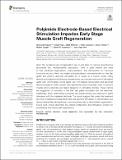| dc.contributor.author | Srinivasan, Shriya Sruthi | |
| dc.contributor.author | Vyas, Keval N | |
| dc.contributor.author | McAvoy, Malia | |
| dc.contributor.author | Calvaresi, Peter | |
| dc.contributor.author | Khan, Omar Fizal | |
| dc.contributor.author | Langer, Robert S | |
| dc.contributor.author | Anderson, Daniel Griffith | |
| dc.contributor.author | Herr, Hugh | |
| dc.date.accessioned | 2019-08-14T15:04:23Z | |
| dc.date.available | 2019-08-14T15:04:23Z | |
| dc.date.issued | 2019-03 | |
| dc.date.submitted | 2018-12 | |
| dc.identifier.issn | 1664-2295 | |
| dc.identifier.uri | https://hdl.handle.net/1721.1/121986 | |
| dc.description.abstract | Given the increasing use of regenerative free muscle flaps for various reconstructive procedures and neuroprosthetic applications, there is great interest and value in their enhanced regeneration, revascularization, and reinnervation for improved functional recovery. Here, we implant polyimide-based mircroelectrodes on free flap grafts and perform electrical stimulation for 6 weeks in a murine model. Using electrophysiological and histological assessments, we compare outcomes of stimulated grafts with unstimulated control grafts. We find delayed reinnervation and abnormal electromyographic (EMG) signals, with significantly more polyphasia, lower compound muscle action potentials and higher fatigability in stimulated animals. These metrics are suggestive of myopathy in the free flap grafts stimulated with the electrode. Additionally, active inflammatory processes and partial necrosis are observed in grafts stimulated with the implanted electrode. The results suggest that under this treatment protocol, implanted epimysial electrodes and electrical stimulation to deinnervated, and devascularized flaps during the early recovery phase may be detrimental to regeneration. Future work should determine the optimal implantation and stimulation window for accelerating free muscle graft regeneration. | en_US |
| dc.description.sponsorship | United States. Department of Defense. Joint Warfighter Medical Research Program (Grant 13207004) | en_US |
| dc.description.sponsorship | National Cancer Institute (U.S.) (Grant P30-CA14051) | en_US |
| dc.language.iso | en | |
| dc.publisher | Frontiers Media SA | en_US |
| dc.relation.isversionof | http://dx.doi.org/10.3389/fneur.2019.00252 | en_US |
| dc.rights | Creative Commons Attribution 4.0 International license | en_US |
| dc.rights.uri | https://creativecommons.org/licenses/by/4.0/ | en_US |
| dc.source | Frontiers | en_US |
| dc.title | Polyimide Electrode-Based Electrical Stimulation Impedes Early Stage Muscle Graft Regeneration | en_US |
| dc.type | Article | en_US |
| dc.identifier.citation | Srinivasan, Shriya et al. "Polyimide Electrode-Based Electrical Stimulation Impedes Early Stage Muscle Graft Regeneration." Frontiers in Neurology 10 (March 2019): 252 © 2019 The Authors | en_US |
| dc.contributor.department | Harvard University--MIT Division of Health Sciences and Technology | en_US |
| dc.contributor.department | Massachusetts Institute of Technology. Department of Chemical Engineering | en_US |
| dc.contributor.department | Massachusetts Institute of Technology. Institute for Medical Engineering & Science | en_US |
| dc.contributor.department | Koch Institute for Integrative Cancer Research at MIT | en_US |
| dc.relation.journal | Frontiers in Neurology | en_US |
| dc.eprint.version | Final published version | en_US |
| dc.type.uri | http://purl.org/eprint/type/JournalArticle | en_US |
| eprint.status | http://purl.org/eprint/status/PeerReviewed | en_US |
| dc.date.updated | 2019-08-09T15:30:56Z | |
| dspace.date.submission | 2019-08-09T15:30:58Z | |
| mit.journal.volume | 10 | en_US |
